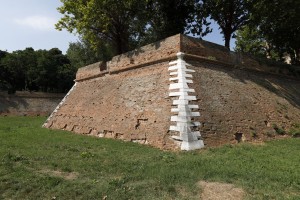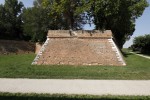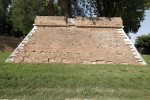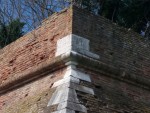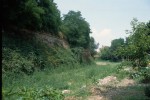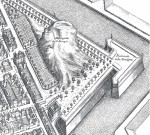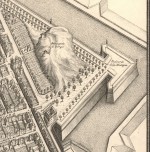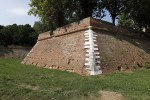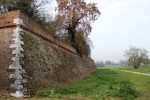Baluardo della Montagna
The green space around the city walls used as a public park, bordered to the north by the Baluardo di San Tommaso and, to the south, near San Giorgio, by the intersection near the Prospettiva della Ghiara arch. It is near the Baluardo della Montagna bastion, built for defensive purposes, the Ducal Baths building and the city's first waterworks.
Name and brief history
The Baluardo della Montagna was built in the sixteenth century, with the Baluardo di San Tommaso, mainly to defend the city. It was used as a military observation point and as a storage site for heavy artillery, especially during the rule of Duke Alfonso I d’Este, after whom the long tree-lined avenue that borders the area to the west (nearest the city centre) is named. Built at the behest of Alfonso himself, this area was once an old quarter called Quartiere della Pioppa, demolished to construct this section of the wall and that which characterised it in the past - and in the present, at least in part. ‘Once it was no longer used for military purposes, that mountain had another destiny: it proved to be a part of the landscape, an intervention modifying the environment, and in this space it remained for the entire series of subsequent events’ (C. Bassi, Nuova Guida di Ferrara. Vita e Spazio nell’Architettura di una Città Emblematica, Italo Bovolenta Editore, Ferrara 1981 p. 248) Subsequently abandoned, it slowly slipped into disrepair until it was restored and increasingly appreciated and promoted in the twentieth century. In 1929, a building owned by the municipality was built on top of the bulwark, used as AMGA workshops until the 1980s. Today it is home to Teatro Off and the Sonika recording studio. The Montagnone, also called the Montagna di San Giorgio (Mountain of St. George) rises next to the bulwark, made of the earth that was excavated from the ditch around the city walls. The city’s first drinking water collection tank stands on its summit. The Montagnone waterworks was opened on 8 June 1890, culmination of long-debated efforts that began on 10 April 1887 with a royal decree, aimed at bringing water to Ferrara through a pipeline from Castelfranco. The entire green space that extends just within the walls is in fact named after the Montagnone. The area is defined by the Baluardo di San Tommaso and, towards San Giorgio, the intersection at the Prospettiva della Ghiara arch. Near the latter, in the part closest to the walls, are the old Ducal Baths, one of the Este delizie (a sort of house) in the city. Carlo Bassi notes how, in the urban fabric of Ferrara, it should be considered ‘one of the most important places in the sequence of the walls’ (p. 252), noting what would appear to be an anomaly. While indeed being a gap with respect to the course of the walls, it would respond to the course of the river and would be the ‘natural conclusion of the course of the Polesine of Sant’Antonio, that is, of the island...joined to the oldest part of the city’ (C. Bassi, p. 249) The Montagnone is generally used as a park and is the site of various events, including recurring ones. The longest-running event held here is the amusement park set up for the feast day of the city's patron saint. In relation to the tree and shrub species present in the park, entering from the Baluardo di San Tommaso and accessing the Montagnone area, one is ‘entirely surrounded by an avenue flanked on the left side by a double row of European nettle trees, then replaced, along the entire wedge-shaped perimeter, by lime trees and, near Porta Romana, by plane trees. Along the raised trail that runs beside the walls, which offers a magnificent view of the curtain walls, the ditches and the Church of San Giorgio, a row of young European nettle trees leads to a spectacular plane tree. The northern area is home to a small playground shaded by poplars, maples, locust trees, plane trees, European nettle and catalpa, and is separated from Viale Alfonso I d’Este by a cotoneaster shrub, that then makes way for plants such as mahonia and Laurustinus. The slopes of the hill are almost entirely occupied by locust trees, poplars, European nettle and a few plane trees, and shrub-like trees such as elders and paper mulberry along the narrow path that runs around the fence of the water tank. Within the gated area, the trees are mainly locust trees, European nettle with trunks covered by ivy, a few thuja and sporadic specimens of ailanthus’ (from Le Mura di Ferrara).
In literature
A mixture of reality and fiction, Giorgio Bassani offers us a unique view of the Montagnone in ‘The Garden of the Finzi-Continis’. The Bassani family home was close by, at 1 Via Cisterna del Follo.
Quotes
In Literature Since childhood I have always suffered from vertigo and though it was a modest climb it had me worried. As a child, when my mother with Ernesto in her arms (Fanny had not yet been born) took me out on Montagnone, and sat down on the grass on the vast square in front of Via Scandiniana, from the top of which one could just barely make out our house’s roof from among the sea of roofs around the big jetty of the church of Santa Maria in Vado, it was with considerable fear, I remember, that I went to lean on the parapet that skirted the square on the side nearest the country, and looked down over a drop of some thirty metres. Someone was always climbing up or down that dizzyingly steep wall: farmers, manual workers, young bricklayers, each of them with a bicycle on his shoulders. Amongst them were old men too, moustachioed frog-catchers and catfish anglers, laden with rods and baskets, all of them inhabitants of Quacchio, of Ponte della Gradella, of Coccomaro, of Coccomarino, of Focomorto, all of them in a hurry, and rather than go the long way by Porta San Giorgio or Porta San Giovanni (because at that time, on that side, the ramparts were still intact, without any penetrable breaches for at least five kilometres) they preferred to take, as they called it, ‘the wall route’. They left the city, in that case, by crossing the great square, passing me by without even noticing me, stepping over the parapet and letting themselves drop until the tips of their toes rested on the first outcrop or crevice in the decrepit wall, and then, in no time at all, they would reach the meadow below. They came from the country; and then they would come up with those narrowed eyes that seemed to me to be boring into my own as I peeped timidly over the parapet – but I was quite wrong about that as they were understandably only focusing on the next handhold. Always, in any case, all the time they were thus occupied, suspended over the abyss – a pair of them, usually, one following the other – I would hear them chattering away in dialect, no more or less perturbed than if they had been trudging along a footpath in the middle of some fields. How calm, strong and brave they were! – I’d tell myself. ...I’d never be able to do such a thing, I told myself every time, watching them move away, full of admiration but also a kind of recoil. Never ever.’ (G. Bassani, ‘The Garden of the Finzi-Continis’, in The Novel of Ferrara, translated by Jamie McKendrick, Penguin Classics, 2018, e-book location 4518-4536) On the entrance to the Montagnone and its gardens: ‘The Prospettiva della Ghiara arch, at the intersection of Via Formignana and Via XX Settembre (which we will henceforth call Via della Ghiara) was the gate that gave way to the wonderful, orderly gardens around the mountain and which seems to have continued surrounding the entire city with 18 delizie, running on the ramparts of the walls. The descriptions of historians of these places of serenity are fascinating in part because they document a city that took care of its image and that knew how to present itself to outsiders who visited it.’ (C. Bassi, Nuova Guida di Ferrara. Vita e Spazio nell’Architettura di una Città Emblematica, Italo Bovolenta Editore, Ferrara, p. 166) On the availability of drinking water in Ferrara: ‘The first pipe of the 57-kilometre pipeline that brought water from Castelfranco to Ferrara was set on 14 June 1887. Its course ended in the Montagnone area, where there was an underground tank able to hold 1,054 m3 of water, with two collection pools and two chambers for the entry and exit valves. The water arrived to houses via cast iron pipes (measuring 50-300 mm in diameter) in a 17.5 kilometre network. Twelve water fountains were spread about the city and four in the suburbs, in addition to a circular fountain (6.20 m in diameter) in the ‘public gardens’ of the Castle. The last tube in the pipeline was put in place on 22 October 1889, and on 4 November, water first reached houses with plumbing systems. The inspection on 31 May 1890 confirmed that there were no leaks in the pipes from Castelfranco to Ferrara. Holding a big event, the town council and Mayor, Count Carlo Giustiniani, invited the residents of Ferrara to the inauguration, held 8 June 1890, of the first drinking water collection tank, the Montagnone aqueduct “a great and beneficial work”’. (from A. Ghinato, Acqua a Ferrara)
Bibliography
- Ugo Malagù, Le mura di Ferrara, Ferrariae Decus-Ente Provinciale per il Turismo, Ferrara 1960
- Carlo Bassi, Nuova guida di Ferrara. Vita e spazio nell’architettura di una città emblematica, Italo Bovolenta editore, Ferrara 1981
- Giovanni Maria Zerbinati, a cura di Maria Giuseppina Muzzarelli, Croniche di Ferrara. Quali comenzano del anno 1500 sino al 1527, Deputazione Provinciale Ferrarese di Storia Patria, XVI 1989
- Bassani, Giorgio, Il giardino dei Finzi Contini, Mondadori, Milano 2001
- Francesco Scafuri, Le mura di Ferrara. Un itinerario attorno alla città, tra storia ed architettura militare, in Maria Rosaria Di Fabio (a cura di), Le mura di Ferrara. Storia di un restauro, Minerva, Bologna 2003
- Melchiorri, Gerolamo, Bassi, Carlo, Nomenclatura ed etimologia delle piazze e strade di Ferrara. Ampliamenti all'opera di Gerolamo Melchiorri, 2G, Ferrara 2009
- Carlo Bassi, Ferrara rara. Perché Ferrara è bella, Archivio Cattaneo editore in Cernobbio, 2015
- Andrea Marchesi, Delizie d'archivio. Regesti e documenti per la storia delle residenze estensi nella Ferrara del Cinquecento, Tomo II, Dimore urbane, Le Immagini edizioni, Ferrara 2015
- Andrea Marchesi, Non solo Rossetti: Bramante e Sebastiano da Monselice (alias Barbazza) nella committenza architettonica di Alfonso I d'Este, in Andrea Marchesi, Marialucia Menegatti, «Grande così quanto forse ignorato»: omaggio a Biagio Rossetti, «Ferrariae Decus. Studi-Ricerche», 33, 2018
- Andrea Marchesi, Tra Prisciani e Rossetti: un progetto di Bramante per Alfonso I d'Este, in Alessandro Ippoliti (a cura di), Biagio Rossetti e il suo tempo, Atti del convegno (Ferrara, 24-26 novembre 2016), Ginevra Bentivoglio Editoria, Roma 2018
Sitography
- http://www.ferraraoff.it/
- https://www.ottocentoferrarese.it/component/k2/item/25-acqua.html
- http://bbcc.ibc.regione.emilia-romagna.it/pater/loadcard.do?id_card=196603
- http://ricerca.gelocal.it/lanuovaferrara/archivio/lanuovaferrara/2004/11/15/UL2PO_UL201.html
- https://it.wikipedia.org/wiki/Baluardo_della_Montagna
- https://it.wikipedia.org/wiki/Mura_di_Ferrara
Fototeca
Related Themes
Compiling entity
- Assessorato alla Cultura e al Turismo, Comune di Ferrara
Author
- Barbara Pizzo

